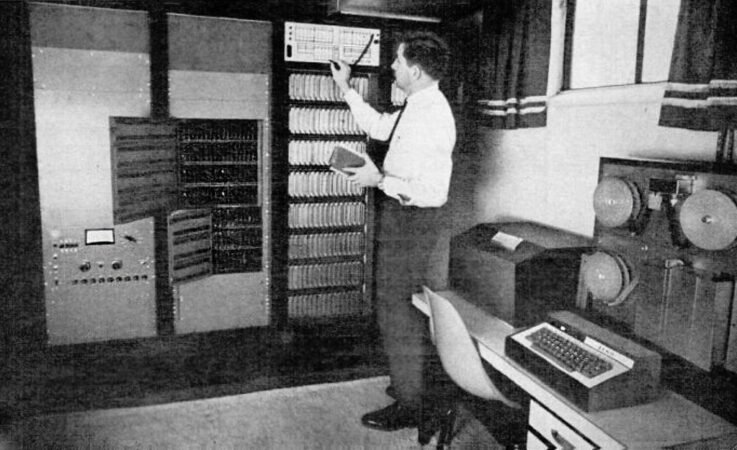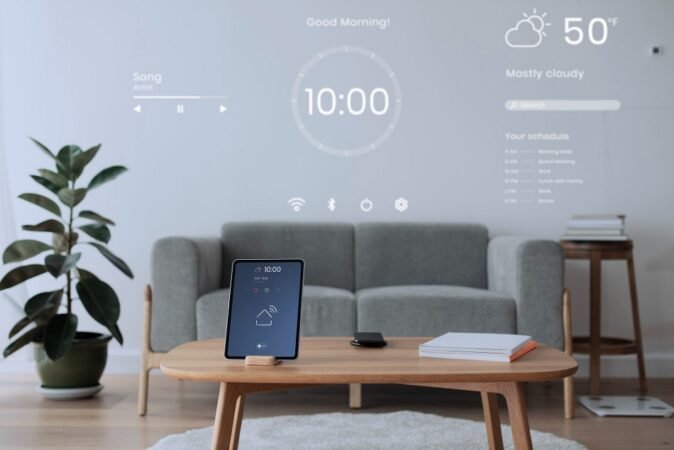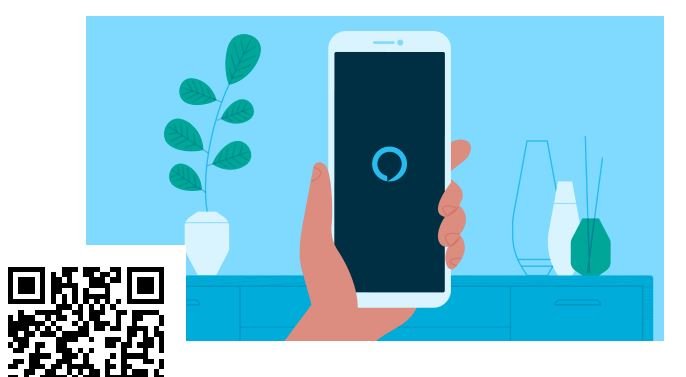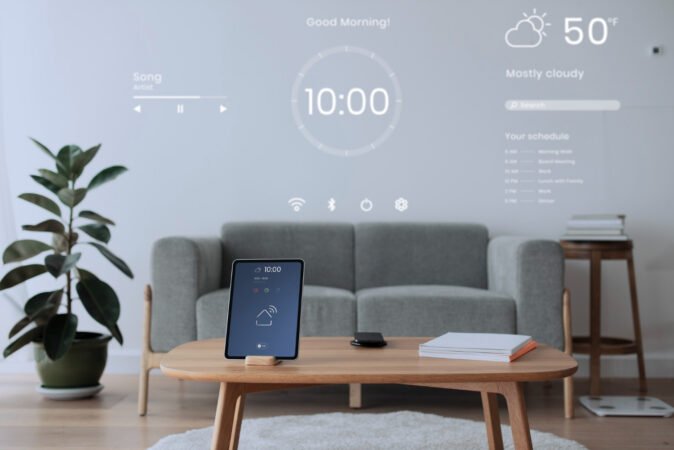The Evolution of Smart Home automation:
The evolution of smart home technology has been a long and winding road, but it has come a long way in a relatively short amount of time. The first smart home technology was developed in the 1970s, but it was not until the early 2000s that smart home technology really began to take off.

Smart home automation has come a long way since its humble beginnings in the early 1970s. Today, smart home devices are more affordable, accessible, and user-friendly than ever before. And with the rise of artificial intelligence (AI) and the Internet of Things (IoT), smart home automation is poised to revolutionize the way we live and interact with our homes.
The early days of smart home automation
Smart home automation is the process of automating and controlling your home’s devices and systems remotely. This can include things like turning on the lights, adjusting the thermostat, locking the doors, and even running the dishwasher. Smart home technology has become increasingly popular in recent years, but it has a long history dating back to the early 1970s.
The first smart home devices
The first smart home device was the ECHO IV, which was invented in 1966. The ECHO IV was a computer that could be used to control a variety of home appliances, such as the lights, thermostat, and oven. However, the ECHO IV was never commercially sold, and it was many years before smart home technology became widely available.

In 1975, X10 was introduced. X10 is a communication protocol that allows devices to communicate with each other over a home’s electrical wiring. X10 was the first commercially successful smart home technology, and it was used to control a variety of devices, including lights, thermostats, and security systems.
The growth of smart home automation
Throughout the 1980s and 1990s, smart home automation technology continued to develop. New devices were introduced, and existing devices became more affordable and easier to use. In the early 2000s, wireless smart home technologies such as Zigbee and Z-Wave were introduced. These wireless technologies made it even easier to install and use smart home devices.

In recent years, smart home technology has become even more popular, thanks in part to the rise of smartphones and tablets. Many smart home devices can now be controlled using a smartphone app, making it easier than ever to manage your home’s devices and systems remotely.
The rise of wireless and its impact on smart home automation
Wireless technology has come a long way in recent years, and its impact on smart home automation is undeniable. From Wi-Fi and Bluetooth to Zigbee and Z-Wave, wireless protocols provide a convenient and reliable way to connect and control smart devices throughout the home.

One of the biggest advantages of wireless smart home automation is that it eliminates the need for complex wiring and installation. This makes it much easier and more affordable to get started with smart home automation, and it also allows homeowners to add new devices to their system over time without having to worry about running wires.
Another advantage of wireless smart home automation is that it provides greater flexibility and scalability. Wireless devices can be placed anywhere in the home, regardless of proximity to a power outlet or Ethernet cable. This makes it possible to create more complex and sophisticated smart home systems that meet the specific needs of each homeowner.
In addition, wireless smart home automation is becoming increasingly affordable and accessible. The cost of wireless smart devices has fallen dramatically in recent years, and there is now a wide range of devices available to choose from. This makes it possible for homeowners of all budgets to create a smart home system that works for them.
Smart home automation and the rise of wireless
Smart home automation is the use of technology to automate and control various tasks in the home. This can include things like turning on and off lights, adjusting the temperature, and locking and unlocking doors. Smart home automation systems can be controlled remotely using a smartphone or tablet, or they can be programmed to operate automatically based on certain triggers, such as time of day or occupancy.
The rise of wireless technology has revolutionized smart home automation. In the past, smart home systems were typically wired, which made them expensive and difficult to install. However, wireless smart home devices are now much more affordable and easier to set up. This has made smart home automation more accessible to a wider range of homeowners.
Benefits of wireless smart home automation
There are many benefits to using wireless smart home devices, including:
- Convenience: Wireless smart home devices can be controlled remotely using a smartphone or tablet. This makes it easy to manage your home from anywhere in the world.
- Flexibility: Wireless smart devices can be placed anywhere in the home, regardless of proximity to a power outlet or Ethernet cable. This gives you more flexibility when designing your smart home system.
- Scalability: Wireless smart home systems are scalable, meaning you can add new devices to your system over time without having to worry about running wires.
- Affordability: Wireless smart home devices are becoming increasingly affordable. This makes smart home automation more accessible to homeowners of all budgets.
Examples of wireless smart home devices
There are a wide variety of wireless smart home devices available on the market today. Some of the most popular types of devices include:
- Smart lights: Smart lights can be controlled remotely using a smartphone or tablet. You can also program them to turn on and off automatically at certain times of day.
- Smart thermostats: Smart thermostats can be programmed to learn your heating and cooling preferences and adjust the temperature accordingly. This can help you save money on your energy bills.
- Smart doorbells: Smart doorbells allow you to see and speak to visitors at your door even when you’re not home.
- Smart locks: Smart locks allow you to lock and unlock your doors remotely using a smartphone or tablet. You can also create custom access codes for guests and family members.
- Smart security systems: Smart security systems can be used to monitor your home for intruders and send alerts to your smartphone if anything goes wrong.
The rise of wireless technology has had a major impact on smart home automation. Wireless smart devices are now more affordable and easier to install than ever before, making them accessible to a wider range of homeowners. Wireless smart home automation systems offer a number of benefits, including convenience, flexibility, scalability, and affordability.
The era of smartphones: Smart home automation
Smartphones have become an integral part of our lives. We use them for everything from staying connected with friends and family to checking the weather to getting directions. But smartphones are more than just communication devices. They can also be used to control our homes.

Smart home automation is the use of technology to automate tasks in the home. This can include things like turning on lights, adjusting the thermostat, and locking doors. Smart home automation can be controlled using a variety of devices, including smartphones, tablets, and computers.
One of the most popular ways to use smartphones for smart home automation is through the use of voice assistants. Voice assistants such as Siri, Google Assistant, and Alexa allow you to control your smart home devices using your voice. For example, you can say “Hey Siri, turn on the living room lights” to turn on the lights in your living room.
Another popular way to use smartphones for smart home automation is through the use of apps. There are a variety of smart home automation apps available, both free and paid. These apps allow you to control your smart home devices from your smartphone. For example, you can use the Nest app to adjust the temperature in your home or the Philips Hue app to change the color of your lights.
Smart home automation can offer a number of benefits. It can help you to save energy, improve security, and make your life more convenient. For example, you can use smart home automation to turn off lights when you leave the room or to lock your doors when you go to bed. You can also use smart home automation to create custom routines, such as a “good night” routine that turns off lights, locks doors, and sets the thermostat to a comfortable temperature.
If you are interested in using your smartphone for smart home automation, there are a few things you need to do to get started. First, you need to make sure that your home is compatible with smart home devices. There are a variety of smart home devices available, so you can choose the ones that are right for your needs.
Once you have chosen your smart home devices, you need to install them and connect them to your Wi-Fi network. Once your smart home devices are connected to your Wi-Fi network, you can download the smart home automation apps that you need to control them.
Once you have downloaded the smart home automation apps, you can start controlling your smart home devices using your smartphone. You can use voice assistants, apps, or both to control your smart home devices.
Smart home automation is a rapidly growing field, and there are new devices and apps being released all the time. If you are interested in using your smartphone for smart home automation, there is no better time to start than now.
Here are some tips for using your smartphone for smart home automation:
- Start with a few devices. You don’t need to buy all of the smart home devices available right away. Start with a few devices that you think will be most useful to you.
- Choose devices that are compatible with each other. Make sure that the smart home devices you choose are compatible with each other. This will make it easier to control them using your smartphone.
- Set up routines. Routines can help you to automate common tasks, such as turning off lights when you leave the room or locking doors when you go to bed.
- Use voice assistants. Voice assistants can make it easier to control your smart home devices. You can use voice assistants to turn on lights, adjust the thermostat, and more.
- Take advantage of security features. Many smart home devices offer security features, such as motion detection and remote locking. Take advantage of these features to keep your home safe.
Smart home automation can offer a number of benefits. It can help you to save energy, improve security, and make your life more convenient. If you are interested in using your smartphone for smart home automation, there are a few things you need to do to get started. Start by choosing a few devices that are compatible with each other and setting up routines. You can also use voice assistants to make it easier to control your smart home devices and take advantage of security features.
The rise of AI and IoT: Smart home automation for a more convenient and efficient future
Artificial intelligence (AI) and the Internet of Things (IoT) are two of the most transformative technologies of our time. AI is the ability of machines to learn and think like humans, while IoT is the network of physical devices that are connected to the internet and can collect and exchange data.

Together, AI and IoT are revolutionizing the way we live and work. One of the most exciting areas where these technologies are having a major impact is in smart home automation.
Smart home automation is the use of AI and IoT to automate and control various aspects of the home, such as lighting, heating, cooling, security, and entertainment. Smart home devices can be controlled remotely using a smartphone, tablet, or computer, or even by voice commands using a smart speaker.
The market for smart home devices is growing rapidly, and there are now a wide variety of devices available to choose from. Some of the most popular smart home devices include:
- Smart thermostats
- Smart door locks
- Smart lights
- Smart security cameras
- Smart water leak detectors
- Smart smoke detectors
- Smart speakers
- Smart TVs
To get started with smart home automation, you’ll need to choose a smart home platform. Smart home platforms are software applications that allow you to connect and control your smart home devices from a single place. Some popular smart home platforms include:
- Google Home
- Amazon Alexa
- Apple HomeKit
Once you’ve chosen a smart home platform, you can start adding smart home devices to your home. Most smart home devices are easy to install and set up, and many of them can be controlled using your smartphone or tablet.
As AI and IoT technology continues to develop, we can expect to see even more innovative and sophisticated smart home devices and solutions in the future. Smart home automation is poised to revolutionize the way we live and work, making our homes more convenient, efficient, and secure.
The future of smart home automation
Smart home automation is the use of technology to control your home’s features and appliances remotely. This can include things like turning on your lights, adjusting your thermostat, or locking your doors. Smart home automation is becoming increasingly popular, as it can make your life more convenient and save you money on your energy bills.
The future of smart home automation is very bright. As technology continues to develop, we can expect to see even more innovative and useful smart home products and services come to market. Here are some of the trends that we can expect to see in the future of smart home automation:
- More integration: Smart home devices are becoming increasingly integrated with each other, making it easier to control your entire home from a single app. For example, you can now use your smart speaker to control your smart lights, thermostat, and other devices.
- More artificial intelligence: Artificial intelligence (AI) is playing an increasingly important role in smart home automation. AI-powered smart home systems can learn your habits and preferences over time, and then automate your home accordingly. For example, an AI-powered smart home system might learn that you like to turn on your lights and turn up the heat when you come home from work.
- More voice control: Voice control is another trend that is becoming increasingly popular in smart home automation. With voice control, you can control your smart home devices simply by speaking to them. This makes it even easier to control your home, especially if you have your hands full.
Smart home automation is still a relatively new technology, but it is growing rapidly. With the increasing convenience, energy savings, and security that smart home automation offers, it is no wonder that it is becoming increasingly popular. If you are interested in learning more about smart home automation, there are many resources available online and in stores.
Smart home automation today
Smart home automation is the use of technology to automate and control various aspects of your home, such as lighting, climate control, security, and entertainment. It can be used to make your life more convenient, secure, and energy-efficient.
Smart home devices can be controlled remotely using a smartphone app or voice assistant, such as Amazon Alexa or Google Assistant. This makes it easy to manage your home even when you’re not there.
Smart home automation is becoming increasingly popular, as the technology becomes more affordable and accessible. Today, there is a wide range of smart home devices available, from basic light bulbs to sophisticated thermostats and security systems.
The smart home market is growing rapidly, and new devices and features are being released all the time. Some of the latest trends in smart home automation include:
- Voice control: Voice assistants like Amazon Alexa and Google Assistant are making it easier than ever to control your smart home devices. You can use voice commands to turn on and off lights, adjust the thermostat, and set alarms.
- Artificial intelligence (AI): AI is being used to develop new smart home devices that are more intelligent and proactive. For example, AI-powered thermostats can learn your heating and cooling habits and adjust the temperature accordingly.
- Interconnectivity: Smart home devices are becoming increasingly interconnected, allowing you to create more complex automations. For example, you could program your lights to turn on and your thermostat to adjust the temperature when you open the front door.
Smart home automation is a great way to make your life more convenient, secure, and energy-efficient. With the wide range of devices and features available, there is something for everyone.
Benefits of smart home automation
Smart home automation is the use of technology to connect and control your home’s devices and systems. This can include everything from your lights and thermostat to your security system and appliances.
There are many benefits to smart home automation, including:
- Convenience: Smart home devices can be controlled from anywhere in the world, using your smartphone or tablet. This means you can turn on your lights before you even get home, or adjust your thermostat while you’re at work.
- Energy efficiency: Smart thermostats can learn your heating and cooling habits and adjust the temperature accordingly, saving you money on your energy bills. Smart lights can also be programmed to turn off when you leave a room or go to bed.
- Security: Smart security systems can monitor your home for intruders and send you alerts if anything goes wrong. You can also use cameras to check in on your home remotely.
- Peace of mind: Knowing that your home is secure and that you can control your devices from anywhere can give you peace of mind, especially when you’re traveling or away from home for extended periods of time.
Smart home automation for everyone
Smart home automation is becoming more and more affordable and accessible, making it a great option for homeowners of all budgets. There are many different smart home devices and systems available, so you can choose the ones that are right for you and your needs.
Here are a few examples of how you can use smart home automation in your home:
- Turn on your lights before you get home. This is a great way to deter burglars and make your home feel more welcoming when you arrive.
- Adjust your thermostat while you’re at work. Save money on your energy bills by setting your thermostat to a lower temperature during the day and raising it when you get home.
- Turn off your lights when you leave a room. This is another great way to save energy and reduce your carbon footprint.
- Monitor your home for intruders. Smart security systems can send you alerts if they detect any unusual activity in your home.
- Check in on your home remotely. Use smart cameras to see what’s going on in your home, even when you’re not there.
Getting started with smart home automation
If you’re interested in getting started with smart home automation, there are a few things you need to do:
- Choose the right devices and systems for you. There are many different smart home devices and systems available, so it’s important to choose the ones that are right for you and your needs. Consider your budget, your lifestyle, and the features that are most important to you.
- Set up your devices. Once you have chosen your smart home devices and systems, you need to set them up. This process will vary depending on the device, but most devices can be set up using a smartphone app or a web browser.
- Integrate your devices. Many smart home devices can be integrated with each other, so you can create a seamless smart home experience. For example, you can program your smart lights to turn on when you arrive home, or you can program your smart thermostat to adjust the temperature when you go to bed.
Conclusion
Smart home automation is a great way to make your home more convenient, energy-efficient, and secure. With so many different smart home devices and systems available, there is something for everyone. If you’re interested in getting started with smart home automation, there are many resources available to help you choose the right devices and systems for your needs.
Here are some of the key milestones in the evolution of smart home technology:
| Year | Milestone |
|---|---|
| 1966 | ECHO IV |
| 1975 | The Nest Learning Thermostat has been released. |
| 2000 | The Zigbee and Z-Wave wireless standards are released. |
| 2010 | Amazon Echo has been released. |
| 2014 | Amazon Echo is released. |
| 2015 | Apple HomeKit is released. |
| 2020 | The COVID-19 pandemic accelerates the adoption of smart home technology. |
The future of smart home technology is bright. As technology continues to evolve, we can expect to see even more ways to make our homes more convenient, secure, and energy-efficient.
FAQs on the Evolution of Smart Home Automation:
- Q: When did the concept of smart home automation begin?
A: The concept of smart home automation began to take shape in the early 20th century with basic automated systems for tasks like controlling lights and appliances. - Q: What were the key advancements that transformed smart homes?
A: The integration of the internet, the introduction of voice-controlled smart speakers, and the development of AI algorithms were key advancements that transformed smart homes. - Q: How did the COVID-19 pandemic impact smart home technology adoption?
A: The COVID-19 pandemic accelerated the adoption of smart home technology as people sought remote control, automation, and enhanced home security features to adapt to changing lifestyles.
- Q: What role does IoT (Internet of Things) play in smart home automation?
A: IoT enables seamless connectivity and communication between various smart devices, allowing them to interact and exchange data, which enhances the automation and intelligence of smart home systems. - Q: How has smart home automation contributed to energy efficiency?
A: Smart home automation has significantly contributed to energy efficiency by enabling users to monitor and control energy-consuming devices, optimize heating and cooling systems, and implement energy-saving routines, resulting in reduced energy consumption and lower utility bills.
Check out our other blog posts:
The Future of Smart Home Automation
Smart Home Automation Market Forecast and Trends to 2029
Smart Home Automation: An Introduction
The Pros and Cons of Smart Home Automation
Subscribe to our email list to get notified about new blog posts.

